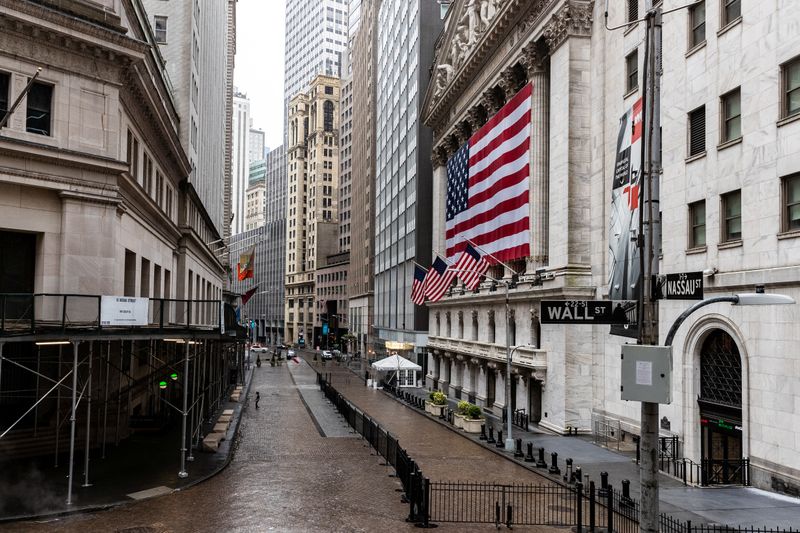By Lucia Mutikani
WASHINGTON (Reuters) - U.S. economic growth likely accelerated in the first quarter, fueled by massive government aid to households and businesses, charting the course for what is expected to be the strongest performance this year in nearly four decades.
The United States' economy is rebounding more quickly compared to its global rivals, thanks to two additional rounds of COVID-19 relief money from Washington as well as easing anxiety over the pandemic, which has boosted domestic demand and allowed services businesses like restaurants and bars to reopen.
Though the anticipated pick-up in gross domestic product last quarter would leave output just below its level at the end of 2019, the economy remains at least a couple of years away from fully recovering from the pandemic recession, which started in February 2020.
The Commerce Department will publish its snapshot of first-quarter GDP growth on Thursday at 8:30 a.m EDT (1230 GMT).
"It will be a solid GDP number," said Ryan Sweet, a senior economist at Moody's (NYSE:MCO) Analytics in West Chester, Pennsylvania. "It's one small milestone in many that we have to hit before we can say we have fully recovered from the recession."
The economy likely grew at a 6.1% annualized rate in the first three months of the year, according to a Reuters survey of economists. That would be the second-fastest GDP growth pace since the third quarter of 2003 and would follow a 4.3% rate in the fourth quarter.
The survey was, however, conducted before this week's March durable goods orders, goods trade deficit as well as wholesale and retail inventories data. Economists at Goldman Sachs (NYSE:GS) initially trimmed their GDP growth estimate by one-tenth of a percentage point to a 7.4% rate after the durable goods data.
They subsequently raised the estimate to a 7.7% pace after the goods trade deficit and inventory data.
Former President Donald Trump's government provided nearly $3 trillion in relief money early in the pandemic, triggering record GDP growth in the third quarter of 2020. That was followed by nearly $900 billion in additional stimulus in late December. President Joe Biden's administration offered another $1.9 trillion rescue package in March, which sent one-time $1,400 checks to qualified households and extended a $300 unemployment subsidy through early September.
The Federal Reserve on Wednesday acknowledged the burgeoning domestic activity, but the U.S. central bank gave no sign it was ready to reduce its extraordinary support for the recovery.
PENT-UP DEMAND
The rapidly accelerating economy could dampen enthusiasm among some moderate Democrats for Biden's ambitious economic agenda. Biden on Wednesday unveiled a sweeping $1.8 trillion package for families and education in his first joint speech to Congress. Republicans oppose more stimulus, now worried about swelling debt. The new package and an earlier infrastructure and jobs plan total around $4 trillion, rivaling the annual federal budget.
There are concerns among some economists that the massive government funding could ignite inflation. Many economists, including Fed Chair Jerome Powell, expect higher inflation will be transitory, arguing that the labor market remains 8.4 million jobs below its peak in February 2020.
A separate report from the Labor Department on Thursday is expected to show 549,000 people filed for state unemployment benefits last week, according to a Reuters survey. Though claims have dropped from a record 6.149 million in early April 2020, they remain well above the range of 200,000 to 250,000 that is viewed as consistent with a healthy labor market. About 17.4 million Americans were receiving unemployment benefits in early April.
The economy continued to power ahead early in the second quarter, with consumer confidence vaulting to a 14-month high in April, thanks to the fiscal stimulus and the expansion of the COVID-19 vaccination program to all American adults. That is helping to unleash pent-up demand.
Americans have accumulated at least $2 trillion in excess savings. Many economists expect the economy will fully recover from the recession in late 2023. They expect growth this year could top 7%, which would be the fastest since 1984. The economy contracted 3.5% in 2020, its worst performance in 74 years.
"Assuming vaccines remain effective against new variants of the virus, the economy should experience significant growth for the rest of the year," said Kevin Cummins (NYSE:CMI), chief U.S. economist at NatWest Markets in Stamford, Connecticut.
"The combination of an extraordinary amount of fiscal stimulus, highly accommodative monetary policy, an extremely positive supply shock as the economy re-opens and a pile of excess savings to support consumption make us extremely optimistic about GDP growth in 2021 and 2022."
Growth in the first quarter was likely driven by consumer spending, which is expected to have accelerated after almost braking in the final three months of 2020. Another quarter of double-digit growth is anticipated for business spending on equipment, as well as a rebound in investment in nonresidential structures such as mining exploration, shafts and wells.
Residential investment likely contributed to GDP growth for a third straight quarter. But trade was likely a drag for the third consecutive quarter as some of the robust domestic demand was satiated with imports. Strong consumption meant fewer unsold goods in warehouses, which likely resulted in inventory accumulation subtracting from GDP growth.
